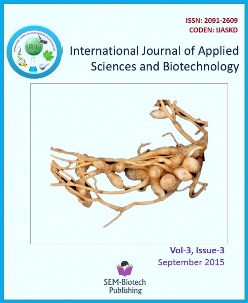Consequences of Environmentally Hazardous Polycyclic Aromatic Hydrocarbon- Anthracene Treatment on Cyanobacteria
DOI:
https://doi.org/10.3126/ijasbt.v3i3.11654Keywords:
anthracene, photosynthetic pigments, metabolic contents, cyanobacteria.Abstract
The study was aimed to determine the chronic toxicity of Polynuclear aromatic hydrocarbon – Anthracene in response to pigments and metabolic study on three different cyanobacterial species such as Synechocystis sp., Anabaena fertilissima, and Nostoc muscorum. Test organisms were treated at different doses and encountered LC50/Mean Lethal Concentration (at which 50% lethality/ growth reduction occur) separately at 7.0 ppm for Synechocystis sp, 5.0 ppm for Anabaena fertilissima and 1.5 ppm for Nostoc muscorum. The influence of anthracene on pigments, metabolites and enzymes was carried out. The test doses caused concentration dependent and decreased pigments like carotenoids and phycobilliproteins. Depletion of carbohydrate by 65 to 80% and proteins by 58 to 78% was encountered with rise in Anthracene concentrations after 16th day exposure in case of Synechocystis sp however, phenols were found to raise by 26 to 37% with increased anthracene concentrations. Similar trend also observed in other two tested blue green algae. Thus the Synechocystis sp.is more tolerant to anthracene treatments as compare to Anabaena fertillissima but Nostoc muscorum showed highest sensitivity to anthracene.
Int J Appl Sci Biotechnol, Vol 3(3): 381-386




